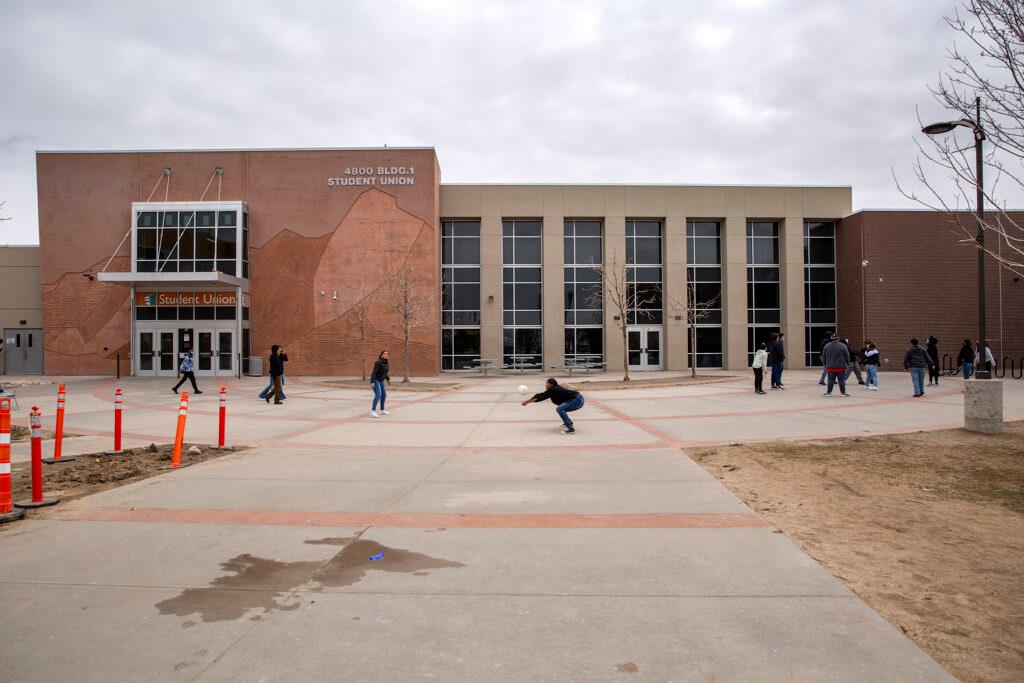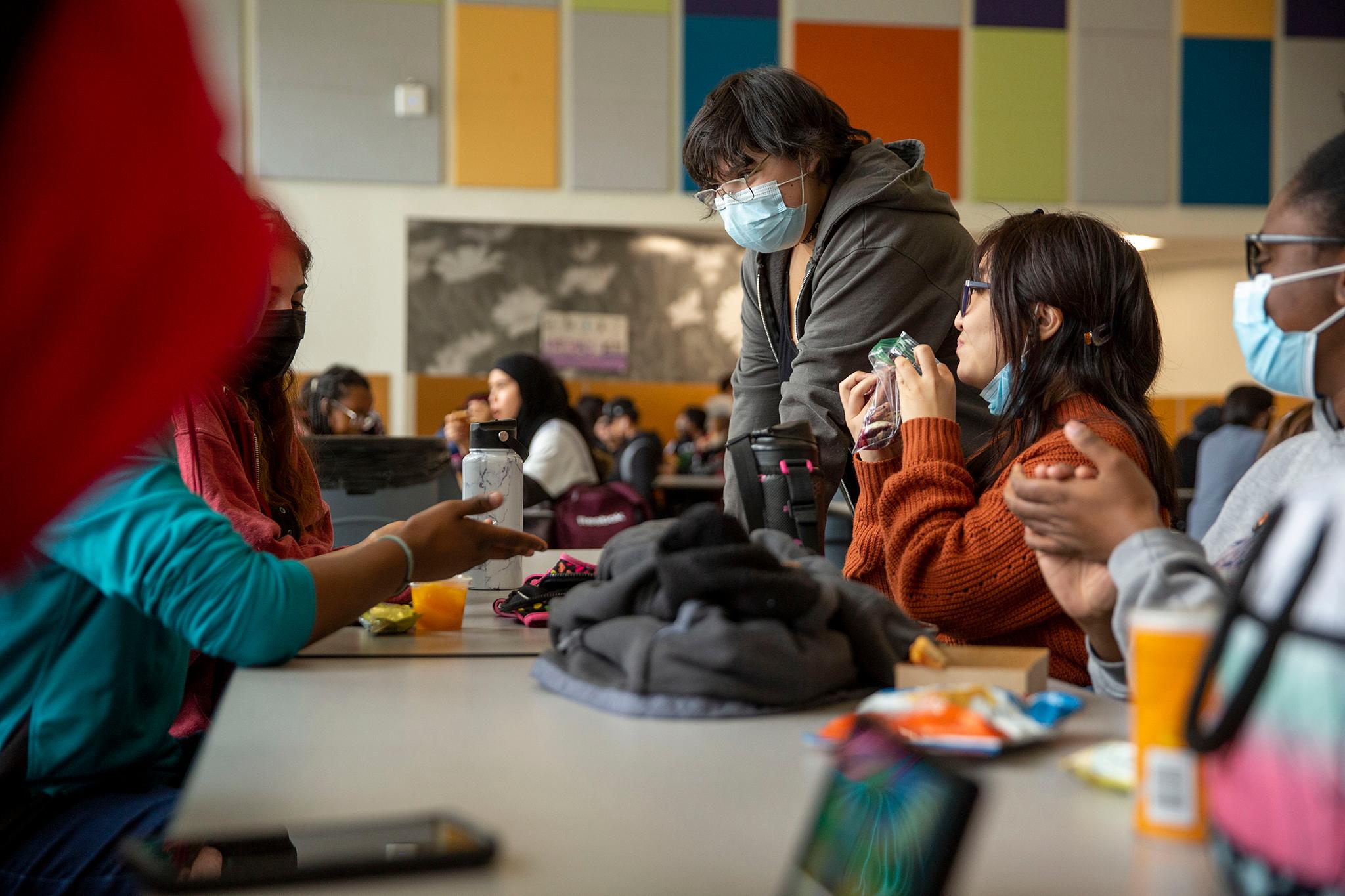
Ash Galaviz, 17, walked into the lunchroom at DSST: Green Valley Ranch High School one recent afternoon, and a bunch of friends were excited. A senior who loves an afterschool nap and watching anime, Ash is working on a book that will soon be self-published.
Ten miles away, Skye O. goes to Denver School of the Arts. The 16-year-old sophomore from Central Park has been fighting, along with other students, to get more bathrooms opened up. She’s easily exhausted after long classes and likes to float from one friend circle to the next.
Ash and Skye are two Denver high schoolers doing the same things other kids their age are doing — hanging out with friends, pursuing creative passions, and getting involved in student activism.
How they’re different from many peers is that they’re among a sliver of increasingly visible students using non-traditional gender markers. And as they leap into the truth of who they are, both of them starting high schools as their true selves, they are finding that nets are in place to catch them — with new policies that honor students’ chosen names and pronouns, create access to restrooms that align with their genders, and deliver lessons that don’t make them feel out of place.
That’s a possible explanation for a sharp increase in students in Denver reporting that they use non-traditional gender markers: At the end of the last school year, 210 out of the Denver Public School’s 93,000 students selected non-traditional descriptions for their gender. It’s a 35 percent increase from the 2020-2021 school year, when 156 did.
The numbers come from hand-counts done by Levi Arithson, Program Manager for LGBTQ+ Equity for Denver Public Schools.
“I went into Infinite Campus and I clicked on each nontraditional gender marker (X, T, and O) and literally counted the number of students marked that way,” he said in an email, adding that his figure is an undercount because it doesn’t capture a student who, for example, self-identified as “female” the first year and “male” the next, or students who aren’t ready to select a non-traditional gender marker.
Although other large school districts don’t collect such data — it is not required by the state — an increasing number of Colorado’s LGBTQ students have felt free to stand up and be counted, anecdotal evidence shows.
“We can assume more students are coming out,” said Bethy Leonardi, Ph.D., Assistant Professor in the School of Education at Colorado University Boulder, and co-director of a Queer Endeavor, a non-profit organization that consults with local schools on LGBTQ inclusivity. “I don’t have hard data on this, but teachers have said, ‘More and more, students are coming out as gender non-conforming or gender-queer.’ That’s just what we are hearing.”
The spike in self-reporting could reflect the positive effect of school policies implemented in recent years in some Colorado schools that aim to celebrate kids like Ash and Skye, while protecting them from harm and discrimination and requiring teachers and other students to create more inclusive spaces and curricula for them.
In January 2020, Denver Public Schools adopted “The Board of Education Resolution on Inclusion for Our LGBTQIA+ Employees, Students and Community Members,” which states that “all students, team members, and community members of the District deserve and are expected to be respected, regardless of their sexual orientation, gender identity, and gender expression.”
Some of the tenets:
- Human resources updated reporting systems so that students and staff could select gender identity options that more accurately reflected who they were;
- School administrations recommitted themselves to having Gender and Sexuality Alliance clubs in elementary, middle and high schools;
- Schools recommitted to respecting each student’s gender identity and sexual orientation even if that student’s family did not;
- Teachers were to call students by their chosen names, regardless of whether they had legally changed them.
- A single-stall, all-gender restroom was required in every DPS school and building.
These changes updated a 2018 DPS policy that objected to infringements on the rights of LGBTQ students, employees, and community members, and pledged to support students through transitions, name changes and inclusive curriculum.
It makes sense for these changes to be happening, according to Leonardi of A Queer Endeavor, which produced a report last month (March 2022) entitled Transgender Students and Policy in K-12 Public Schools: Acknowledging Historical Harms and Taking Steps Toward a Promising Future.
Published by the National Education Policy Center, part of University of Colorado Boulder’s School of Education, the report recommends reducing “structural barriers and immediate harms facing trans students in school,” and creating policies “that allow for gender self-determination.”
It also calls for getting rid of practices that “reinforce inflexible structures surrounding gender,” and implementing curricular changes that include trans and non-binary students.
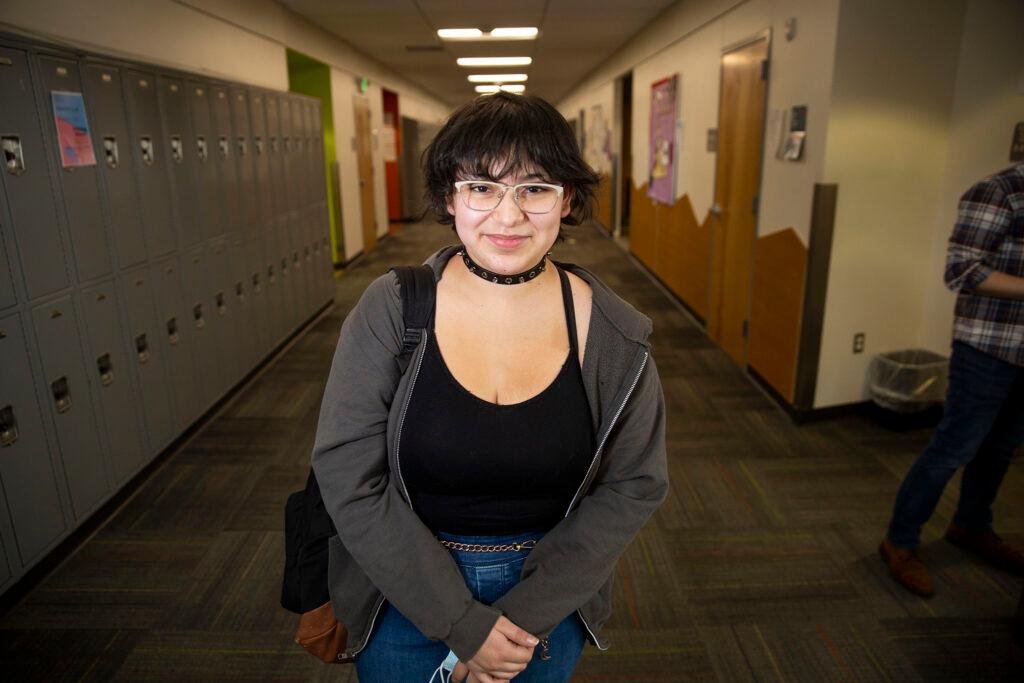
Ash
One such student is Ash, for whom high school graduation is just days away. Coming out as non-binary to their peers at DSST: Green Valley Ranch High during their freshman year happened after some soul-searching.
“I guess it was just an internal debate,” said Ash, wearing a spiked choker necklace, a black top, jeans and glasses, and surrounded by school staffers who’d cleared an interview with Ash’s parents.
“Educating myself helped me realize my identity and, like, how I’m choosing to identify,” Ash explained with a shrug. “I guess I was trying to search up like, if this was, like, normal, if it was right.”
Google research led to self-education when materials in their school library were lacking.
“I finally accepted myself for who I was, ‘cause I was really uneducated.”
After that, it was time to pick a name.
“I literally went on Google and I searched up, uh, gender-neutral names and I went with ‘Ash’ ‘cause I liked it.”
If Ash liked it, they figured, so would everyone else.
“The first day that I made it known to others was when I started going by Ash, I guess that’s when I officially came out. When I started telling my teachers, if I could be called, like, they/them pronouns.”
They also told their classmates.
“I started telling students, like, ‘Hey, I’m non-binary,’ and they would ask me questions.”
Some of the questions were invasive, but Ash realized their classmates were trying to learn. Initially, some hesitated, but soon their friends came around.
As is par for the course for any high-schooler, Ash had some ups and downs, especially after a relationship with a boyfriend who wasn’t a good match, and it affected their academic performance, so Ash went to a therapist.
“It’s definitely helped me a lot more than like I would’ve been able to figure out on my own.”
Plenty of their friends and classmates — 10 out of the 580 that Ash is aware of — are also gender non-conforming. Ash learned that was their good friend Asia’s truth as well.
“We were doing introductions the first day and I was going around asking everyone’s pronouns,” Ash said of a Spectrum group meeting they led. “And they said that they didn’t really care about which pronouns they went by. So I guess that’s like how I figured out that they identified the same way that I did.”
When Ash showed up at the cafeteria, after an interview in the school office that got them out of their Civic Engagement class, a seat had been saved for them by a table full of friends, who greeted them with enthusiasm when they walked in. One of them was Abigail Ayileka.
“Ash, we just like being around them as a person,” Abigail said. “They bring, like, a great vibe to the whole table and they’re so fun to be around.”
Ash says they feel included — most of the time, and that without the new policies, they might not have felt welcome.
“I hear a lot of things that are still pretty upsetting,” Ash said, “but I don’t worry about being physically hurt.”
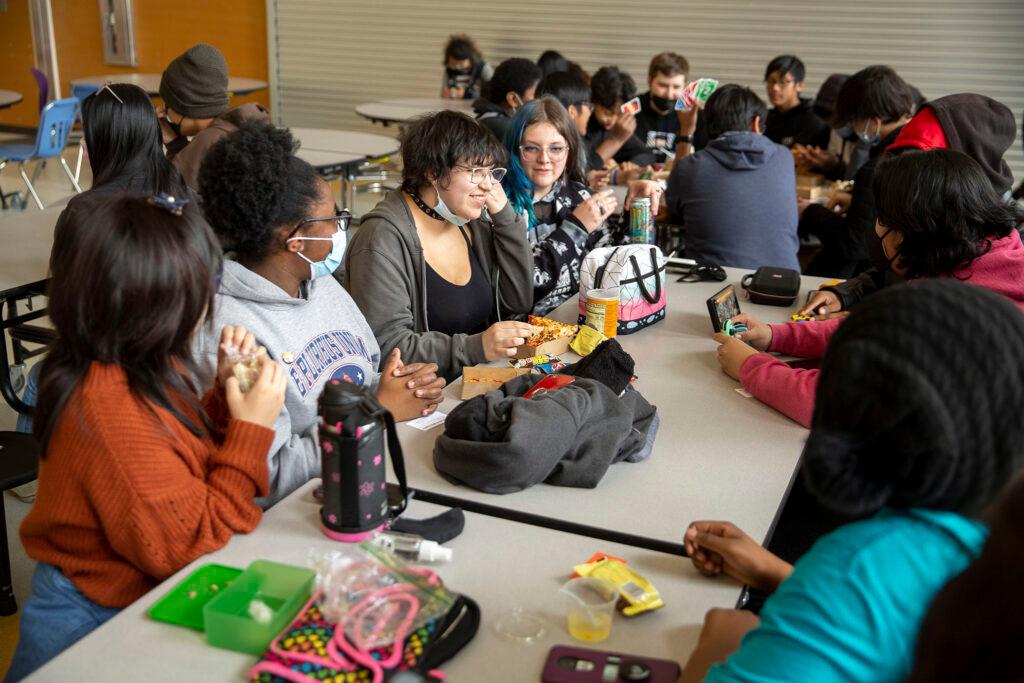
What the data shows
The fear of being physically hurt is real. The 2019 National School Climate Survey, which examines school experiences of LGBTQ students nationally, was conducted between April and August, 2019. It interviewed 16,716 students, ages 13 to 31, from all 50 states, Samoa, Puerto Rico and Guam. It found that:
- 56.9% of LGBTQ students experienced verbal harassment based on gender expression,
- 9.5% of LGBTQ students were physically assaulted in the past year based on gender expression, and
- 27.2% of LGBTQ students reported not being allowed to use the locker room that aligned with their gender identity.
A more recent report shows that trans and non-binary students also experience mental stress. 85% of transgender and/or non-binary youth reported that the recent debates about state laws restricting their rights has impacted their mental health negatively, according to the Trevor Project’s January 2022 report: “Issues Impacting LGBTQ Youth.” It was based on a poll conducted between September and November, 2021, sampling 820 LGBTQ youth online. The study also found that four out of five transgender and/or non-binary youth reported that anti-LABTQ hate crimes, homophobia, transphobia, police bruatlity and racism often give them stress or anxiety.
Locally, statistics show that students who choose non-traditional gender markers face other concerns as well. The Gay Lesbian Straight Education Network (GLSEN) reported in a 2019 National School Climate Survey, which queried 16,713 LGBTQ students from all 50 states, (including 370 respondents who attended school in Colorado, 29 percent of them transgender and 19 percent non-binary) that in Colorado, 2 in 5 transgender students were unable to use the school bathroom aligned with their gender. The report also found that 1 in 3 transgender students were prevented from using their chosen name or pronoun in school.
Skye
Skye O., who lives in Central Park, has felt many of these stressors, including a concern about being physically hurt. During a recent telephone interview, the sophomore at Denver School of the Arts asked that her last name not be used, and that her photograph not be taken, out of concern for her safety.
“I’ve been in scenarios where, through student activism, I’ve been harassed by adult transphobes who have tried to call the police on me and persecute me for standing up to verbal assault,” she said.
Like Ash, Skye has experienced her entire high school career without hiding her gender.
“I came out in the summer between leaving my old school and finding out that I had been accepted to DSA,” she said. “So I didn’t have to go through the trouble of necessarily coming out at DSA, as I was already out to friends and family, and I could simply introduce myself as who I am.”
She wasn’t comfortable coming out sooner, to kids she’d known since kindergarten. Arriving at DSA gave her a chance to start afresh.
“None of my previous identity or conceptions about me attached when people met me,” she said.
She started high school online, when “people could only see the top half of my body.”
Now classes are held in person — some 99 minutes, which leaves her exhausted. Skye has been in classes where about a third of the 1,097 students were transgender or non-binary, which means she doesn’t experience the bullying borne from isolation that LGBTQ students at other schools might. Skye’s friend circle, made up largely of genderqueer classmates, fluctuates.
“I wouldn’t say I have, like, a sort of distinct group of friends. I sort of drift between groups, not in a bad way, and I don’t like being bound by a friend group, so it depends on the day.”
She is part of the school’s literary magazine staff, and has taken courses such as Spanish, math, government, and creative writing, which is her major. She feels particularly drawn to poetry.
She also took honors biology — often a controversial topic as it relates to transgender students. In 2021, Colorado and five other states — Oregon, California, Illinois, New Jersey and Nevada — passed legislation that amended curricular standards so that social science instruction included the contributions of LGBTQ and other historically marginalized communities across the US, a change that research showed resulted in students report feeling safer.
According to Skye, adapting these new guidelines hasn’t been perfect, especially where science courses are concerned.
“I think that the curriculum tends to equate chromosomes with gender,” Skye said, “and not leave room for other chromosomal configurations or gender identity. My teacher last year was great, and she made sure that was not equated, but I don’t think the curriculum itself talks about biology in a more gender-inclusive, gender-broad way.”
There’s not much conversation she knows about related to a more trans and non-binary inclusive academic curriculum — for example, reading literature that includes non-binary characters.
“I don’t think out of any sort of malicious silence, but more can be done to include more transgender non-binary voices in our curriculum and in our education,” she said.
At DSA, there are several single-stall gender-neutral restrooms, but the easily accessible ones have been closed down over safety concerns, forcing students to use a gender-neutral restroom in the office, located at a distance from the classrooms.
“In order to get there, you’d have to ask permission from the check-in desk . . .The idea of going across the school and, like, going back to where admin meets and all that stuff, just to pee, is a very othering experience,” Skye explained. “I’ve met students who said that at that point, they’d just rather misgender themselves and use the gendered restrooms than walk across the whole school in the middle of class.”
Accessibility to gender-neutral restrooms is particularly important at DSA, because sometimes the restrooms double as dressing rooms.
“[Some] students need to change at school because they’re not out to their parents,” Skye said.
Therefore, they leave home wearing clothes that represent the gender identities assigned to them at birth, then rearrange their attire to represent the gender identities they align with who they are in school bathrooms.
The narrowing of bathroom options is an ongoing concern, even if DSA is technically following the rules of the 2020 mandate, she said.
“It’s resulted in a lot of students just not having a place to go in an accessible location, and it’s an issue of a large percentage of the population, having to be feeling uncomfortable while peeing, or just not having the opportunity to have those spaces, so the other students and I have been working on getting them reopened again.”
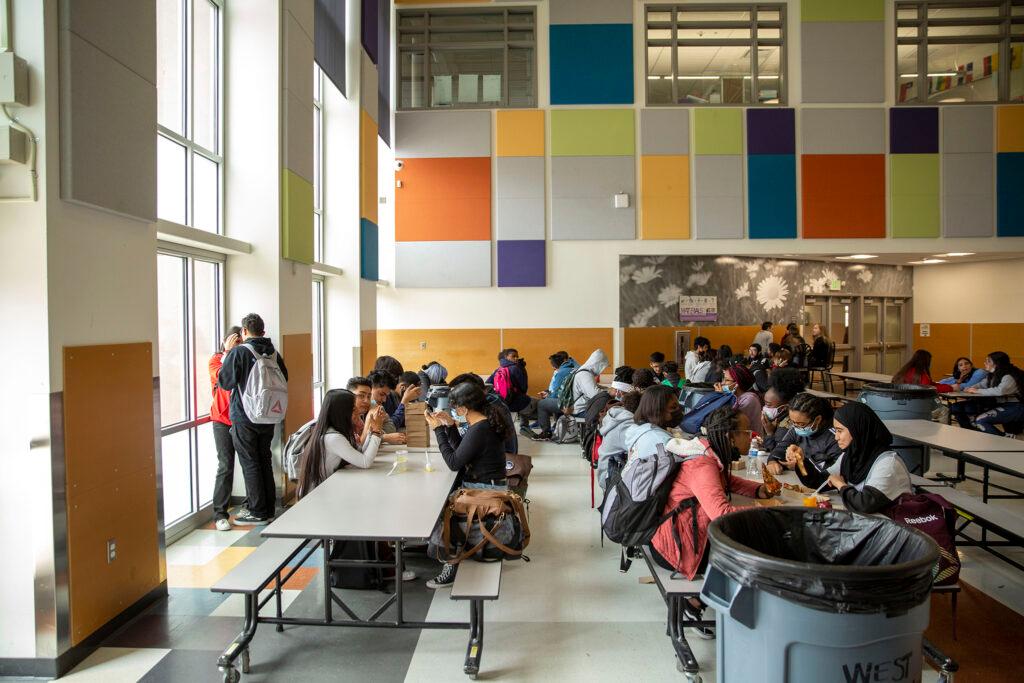
Other districts
Other Colorado school districts are also working on making students using non-traditional gender markers feel included.
The school board of Boulder Valley School District in February approved a resolution reaffirming its commitment to policies introduced ten years before that protect transgender students and employees by providing protocols.
These include students’ right to choose their pronouns, restrooms and locker rooms, as well as their right to change their names and genders in the school system, even if they haven’t done so legally.
A month later, at a March 16, 2022, Adams 12 Five Star school board meeting, several families lined up to thank board members for the implementation of new policies that are more inclusive.
A dad and his two kids, an LGBTQ girl and her non-binary younger sibling, spoke about how much better things had been going for them in school since that district began creating similar new policies.
That school district now has guidelines for supporting transgender and gender non-conforming students that commit to updating students’ chosen names in school records, making their birth-assigned sex confidential, and empowering students with the right to decide who knows their gender.
What’s ahead
Now, as gender creative students are finding ways to express themselves, asking students questions about gender identity could one day be a thing of the past.
Bethy Leonardi of A Queer Endeavor says that for the purpose of students' record-keeping, with new technologies that track students’ gender, finding out which gender markers they would select no longer serves a purpose.
“Sex/gender markers are generally outdated and unnccessary,” she said.
For both Ash and Skye, high school, an often angst-ridden part of adolescence, has been made more complicated by gender, while also being a place for growth, action and change.
“I was just not in the best place when I started here,” explained Ash, who is looking forward to the antics the school mascot might get up to at Senior Signing Day at Denver Coliseum on April 28, and then possibly going on to college. “I’m still not in this super-good place right now to be honest, but, I’m in a better place than I was in, like, my freshman year.”
Meanwhile, Skye intends to continue studying creative writing for two more years, while continuing to fight for a more inclusive school culture.
“It’s rewarding when we are able to make what little progress we can,” she said, “to make sure the school’s more accessible and more equitable for marginalized student gender populations.”
